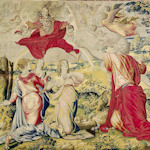
The Kunsthistorisches Museum ends each year with a treat from past centuries. In 2023, an exhibition of monumental Renaissance tapestries designed by Raphael and others adds a stunning splash of gold and silk to dark days.
- Traces the influence of Raphael on tapestry art in the 1500s
- Includes original Raphael drawings
- …and a remarkable highlight from the Vatican Museums
- 18 huge tapestries in total
- c. 100 other items
- Runs Sept 26, 2023 – Jan 14, 2024
- See also:
- Kunsthistorisches Museum overview
- Other art exhibitions in Vienna
Renaissance tapestries
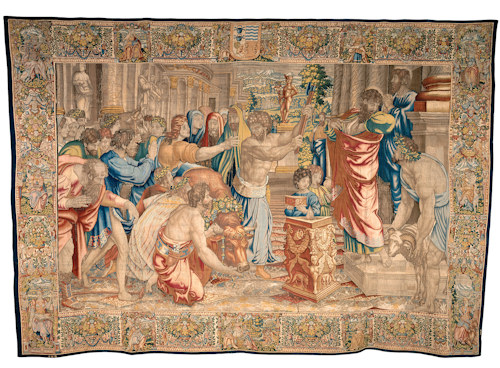
(Sacrifice at Lystra; design by Raphael (1483–1520); from a tapestry series featuring scenes from the Acts of the Apostles, c.1600; Brussels, manufacture of Jakob I. Geubels (died before 1605); wool, silk; Kunsthistorisches Museum Vienna; © KHM-Museumsverband)
Ah, the Renaissance. When we think of its art, we usually turn to paintings, sculptures and architecture. But the era obviously left its mark on all sorts of artistic expression. Including tapestries.
Commissioned by those with the required wealth, monumental tapestries often served as prestige projects for religious institutions and palaces.
Tapestry series, in particular, used detailed pictures to illustrate a suitable story or allegory; a tool for propaganda, politics and preaching the church’s message.
The Raphael: Gold & Silk exhibition focuses on the evolution of this woven art medium across the early 1500s, particularly the influence of Raphael on developments.
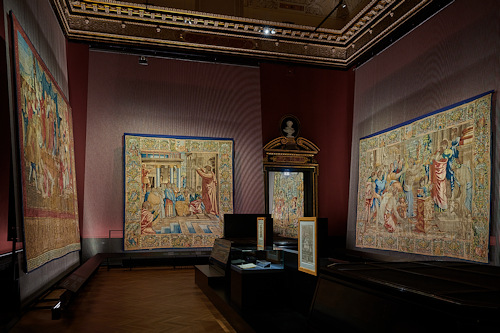
(Exhibition view; press photo © KHM-Museumsverband)
The displays draw on the museum’s own extensive collections and loans from such prestigious institutions as the Louvre, the Albertina, and the Vatican Museums.
A tapestry is only as good as its design, of course, which is where Raphael (1483-1520) comes in: someone has to deliver templates (cartoons) for the workshops to copy and weave their magic in silk and precious threads of gold and silver.
Michelangelo had only recently cleared away his brushes from the Sistine Chapel when Pope Leo X commissioned Raphael to design a set of apostle-themed tapestries for the same building.
Raphael’s painted cartoons proved incredibly influential on the wider art world and helped introduce Renaissance depictive styles into the tapestry domain.

(The Death of Ananias (editio princeps); series title: Depictions from the Lives and the Acts of the Apostles Peter and Paul; design: Raffaello Sanzio da Urbino, known as Raphael (1483– 1520) and workshop, c.1515/16; woven under the direction of Pieter van Aelst, Brussels before 1521; wool, silk, precious-metal-wrapped threads; Musei Vaticani, Vatican City; photo © Governatorato SCV – Direzione dei Musei Vaticani. Tutti i diritti riservati)
The Gold & Silk exhibition opens with six examples based on Raphael’s work for Leo X, with five from around 1600 (some 50 sets of tapestries were produced across the decades using the artist’s designs).
The sixth example is truly remarkable in terms of its place in art and cultural history: one of the original tapestries from that first series produced for the Sistine Chapel in the early 1500s. Wow!
This first room already demonstrates the meaning of monumental: giant wall coverings shimmering even in the low light and after all the passing centuries.
As such, Gold & Silk proves to be one of those exhibitions where pictures cannot do justice to the reality. You can only imagine the looks of awe, humility (and jealousy) induced when the tapestries emerged in public back in the16th century.
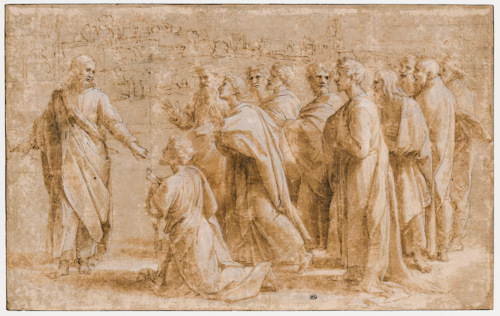
(Christ’s Charge to Peter, Raffaello Sanzio da Urbino, known as Raphael (1483–1520), 1515; pen and brown ink, brown wash, white heightening, over blind stylus and pen in black; Musée du Louvre, Département des Arts Graphiques, Paris; photo © RMN-Grand Palais (Musée du Louvre) / Thierry Le Mage)
We also see the influence of Raphael’s approach (e.g. reducing the number of figures depicted and presenting a clearer narrative) on subsequent works produced in the Flemish heartlands of tapestry manufacture.
An example is another highlight of Gold & Silk: the Seven Deadly Sins tapestry series designed by renowned Flemish artist Pieter Coecke van Aelst (1502-1550).
(Van Aelst, coincidentally, shares a surname with the weaver and workshop owner who produced those original Sistine Chapel tapestries!)
The exhibition presents 18 tapestries in all, but also around 100 supporting objects that include, for example, original drawings by Raphael (!) and historical photos of the cartoons taken in 1859.
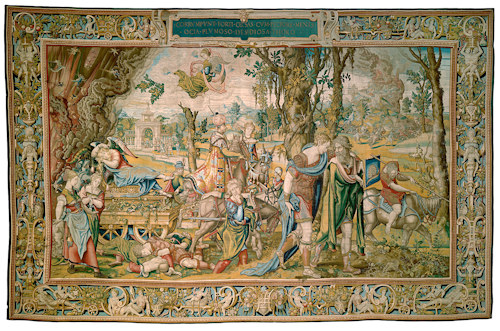
(Sloth (Acedia); tapestry from the series “The Seven Deadly Sins”; design by Pieter Coecke van Aelst (1502–1550), c.1533/34; made under Willem de Pannemaker, Brussels, c.1548/49; wool, silk, wire; H 456 cm, W 708 cm; Vienna, Kunsthistorisches Museum; © KHM-Museumsverband)
We catch a glimpse behind-the-scenes too, with film and drawings of tapestry production techniques and a fascinating video of the storage process at the Kunsthistorisches Museum; they have around 750 historical tapestries in the world’s second-largest such collection.
The tapestry warp (the long threads forming the framework for weaving) seen in the production film appears as a physical motif in the exhibition itself, thanks to its rather clever incorporation into the display architecture.
Raphael might have once said:
Time is a vindictive bandit to steal the beauty of our former selves
…but 500 years has not dulled the impact of his tapestry designs, as Gold & Silk demonstrates.
Dates, tickets & tips
Thread your way through the collection of tapestries from September 26th, 2023 to January 14th, 2024. A valid entrance ticket from or for the Kunsthistorisches Museum includes the exhibition.
Incidentally, Raphael’s depictions of human forms make another appearance in Vienna in the Albertina’s year-end Michelangelo & Beyond exhibition.
And you should find a couple of Raphael’s paintings in the Kunsthistorisches Museum’s picture galleries.
With the exhibition covering the Advent period, note that the square in front of the museum hosts one of Vienna’s best Christmas markets: Weihnachtsdorf Maria-Theresien-Platz.
You won’t find original Renaissance tapestries at the market, but you will find plenty of arts, crafts, food and drink. (Some might argue that the banana slices coated in dark chocolate there represent an art form in their own right.)
How to get there
Just follow the advice at the end of the main Kunsthistorisches Museum page.
Address: Burgring 7, 1010 Vienna